Sturgeon
Large species can swallow whole salmon
Advertisement
Sturgeon Scientific Classification
Read our Complete Guide to Classification of Animals.
Sturgeon Conservation Status
Sturgeon Facts
- Prey
- Shells, crustaceans, small fish
- Fun Fact
- Large species can swallow whole salmon
- Biggest Threat
- Overexploitation
- Most Distinctive Feature
- Elongated body and plates
- Gestation Period
- 8 to 15 days
View all of the Sturgeon images!

The sturgeon, one of approximately 28 species of fish in the family Acipenseridae, is a primitive fish that is found in both saltwater and freshwater environments.
Native to temperate waters of the Northern Hemisphere, sturgeons are among the largest fish and are found in the greatest abundance in the rivers of Ukraine and southern Russia and freshwater areas of North America. More than 85% of sturgeon species are classified as Critically Endangered by the IUCN, making them more critically endangered than any other animal species group.
5 Incredible Sturgeon Facts!
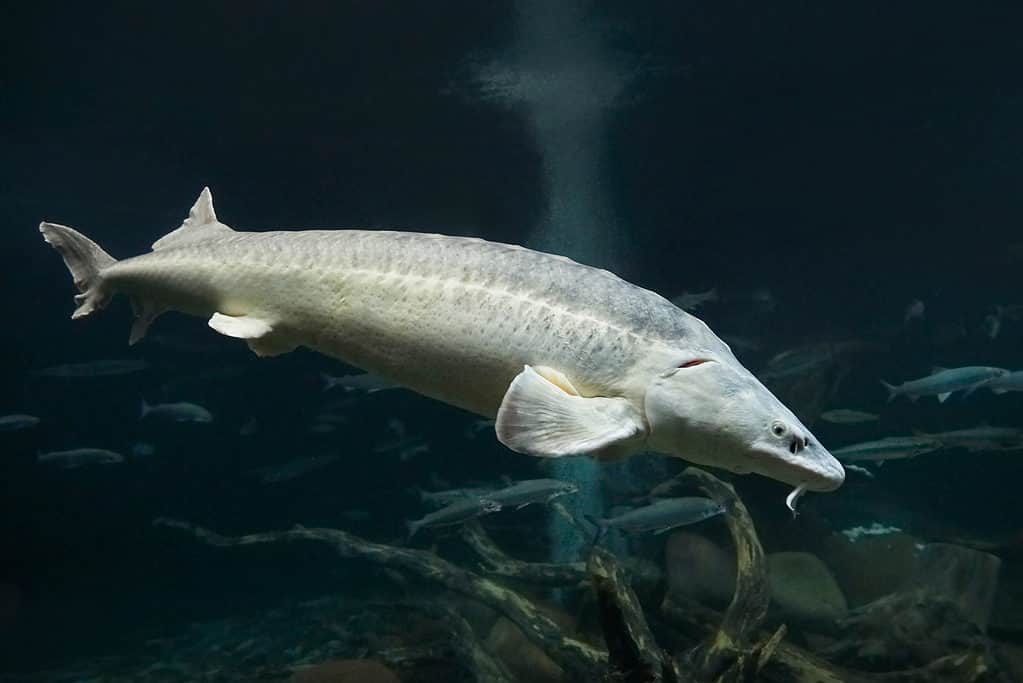
The shortnose sturgeon is a large fish that can grow up to 40 inches. Read on to discover more interesting facts about this big fish!
©pixel creator/Shutterstock.com
- No Teeth: Although massive in size, the sturgeon fish have toothless mouths and consume food by sucking it off of the bottom of rivers, gulfs, lakes, and oceans.
- Caviar: The finest caviar in the world is derived from the roe of several sturgeon species, contributing to the overexploitation of these unique fish.
- Critically Endangered: More than 85% of the sturgeon fish species are at risk of extinction, making them the most critically endangered group of animal species.
- Armored: Sturgeon fish have rows of bony plates called scutes covering their heads and along their bodies.
- Primitive: Because they have undergone very few significant changes for millions of years, they are regarded as primitive fish.
Classification and Scientific Name

They are viewed as primitive fish because they have undergone so little major alteration over millions of years.
©Thesupermat, CC BY-SA 4.0 <https://creativecommons.org/licenses/by-sa/4.0>, via Wikimedia Commons – License
Sturgeons are ray-finned fish belonging to the class Actinopterygii, the order Acipenseriformes and the family Acipenseridae, which includes approximately 28 extant species and six extinct ones. Living species are found in four genera: Acipensar, Huso, Scaphirhynchus, and Pseudoscaphirhynchus.
Acipenseriform fishes first appear in the fossil record during the late Triassic period, roughly 245 million to 208 million years ago. True sturgeons come along on the record starting in the Upper Cretaceous period.
Evolution and Origins
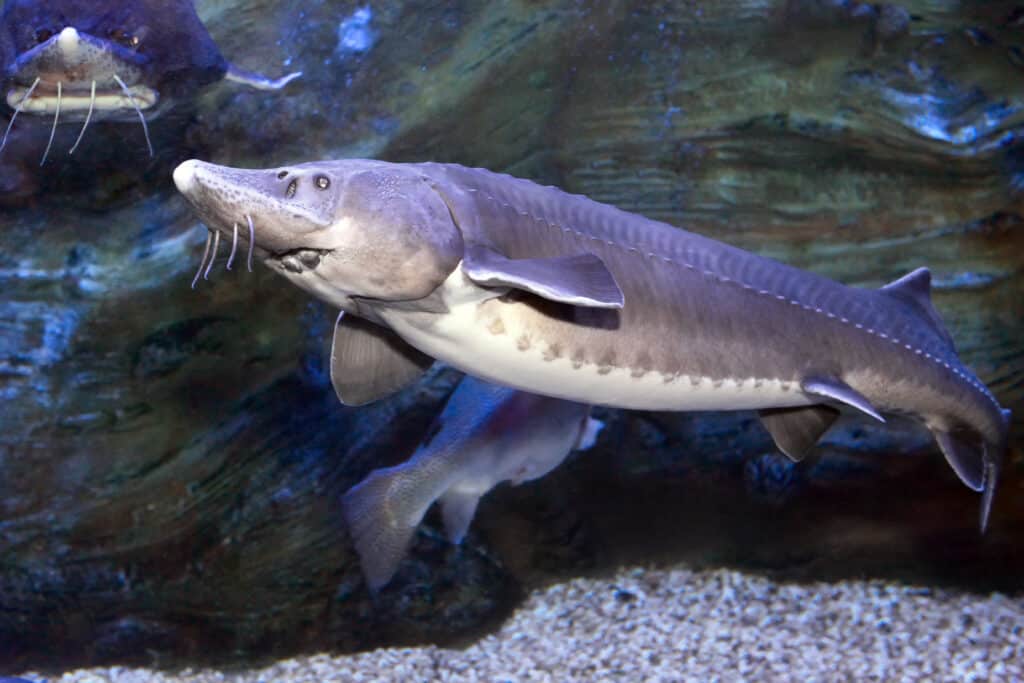
Generally speaking, most people don’t eat the meat of Kaluga sturgeon. Instead, they are highly prized for their roe or caviar.
©Tatiana Belova/Shutterstock.com
Sturgeon fossils can be traced back to the Middle Jurassic era, which spanned from approximately 174 million to 163.5 million years ago. The prevailing belief is that sturgeons originated from the palaeonisciforms, a fish group that emerged towards the end of the Silurian Period, around 419 million years ago.
Sturgeon underwent evolution long prior to the existence of dinosaurs. Their immediate predecessors were able to endure the catastrophic Great Permian Extinction, which resulted in the extinction of 90% of all species, and went on to become the dominant large fish in the primary river systems across North America and Eurasia.
Sturgeons are considered to be ancient creatures and are often likened to dinosaurs. The scientific name given to the white sturgeon is Acipenser transmontanus, which translates to “fish beyond the mountains.” The Columbia River is home to both white and green sturgeon, and they are native to the region.
Species
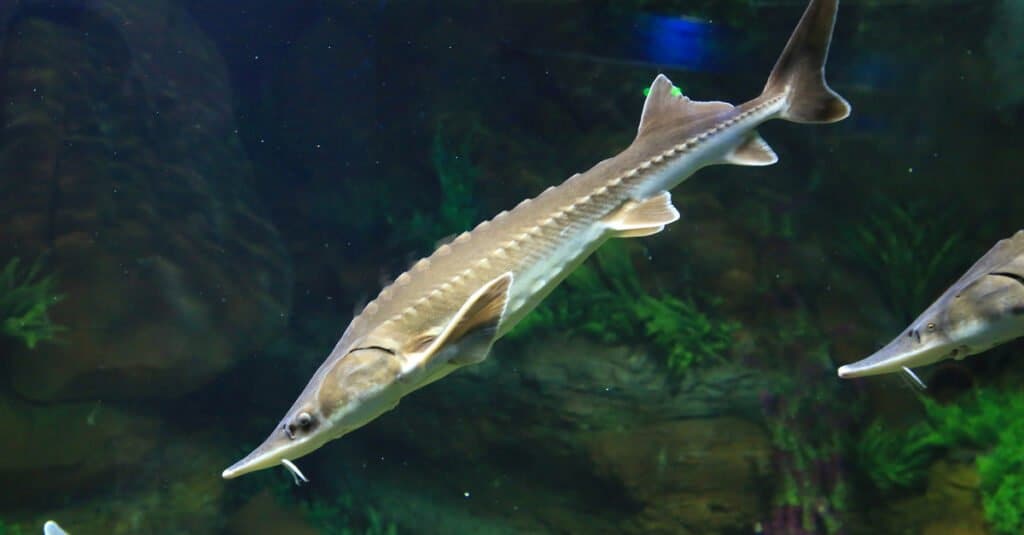
Acipensar sturio is the scientific name for this species.
©Geermy/Shutterstock.com
Some notable sturgeon species include the following:
- Common/Old World Sturgeon – This species, which has the scientific name Acipensar sturio, grows to an average size of 10 feet long and 500 pounds. Its range extends from the Mediterranean Sea to Scandinavia.
- Stellate/Star Sturgeon – This fish, A. stellatus, has a long, pointed snout. Found in the rivers of the Black Sea, Caspian Sea, and the Sea of Azov, it is prized for its valuable caviar, flesh, and isinglass.
- Russian Sturgeon – Found in the rivers of Russia and Lake Baikal, A. guldenstadtii attains an average size of 500 pounds and 10 feet in length.
- Sterlet Sturgeon – A valuable food fish, A. ruthensus is found mostly in rivers feeding the Black and Caspian seas. It reaches an average size of roughly three feet in length.
- Beluga Sturgeon – Among the biggest extant sturgeons, Huso huso can grow to a size of up to 26.2 feet long and up to 3.5 short tons. Its habitat centers around the rivers of the Black Sea, the Caspian Sea, and the Sea of Azov. This giant fish has broken world records with its massive size.
- Lake Sturgeon – The lake sturgeon, A. fulvescens, lives strictly in freshwater habitats. Its habitat includes the Mississippi River basin, the Great Lakes, and major rivers of the West Coast, including the Klamath and the Umpqua rivers. It grows to an average size of 200 pounds. The world record for the largest lake sturgeon was for a specimen measuring 87.5 inches and weighing 240 pounds.
- White/Sacramento/Oregon Sturgeon – Located in waters along the Pacific Coast of North America, A. transmontanus, a giant sturgeon, is the largest of North American sturgeons, attaining a size of up to 1,800 pounds.
- Chinese Sturgeon – This species, A. sinensis, is among the most at risk of all sturgeons and is believed to possibly already be extinct. Found in the Yangtze River basin area of China, it grows to an average size of 13 feet long.
Green Sturgeon
The green sturgeon, Acipensar medirostris, is a species that is native to the Pacific Ocean. Its range spans from China and Russia to Canada and the U.S. Similar in appearance to the white sturgeon, it has a long, narrow snout, and its barbels are closer to its mouth. It has white coloring. The species can grow to a size of up to 7 feet long and up to 350 pounds.
In 2006, the National Marine Fisheries Service, NMFS, classified some populations of these sturgeon as threatened under the Endangered Species Act. These populations are found mostly in the Sacramento River and San Francisco Bay. The NMFS has also listed populations of green sturgeon in the Rogue, Klamath, and Umpqua rivers as a Species of Concern.
Appearance

The bodies of these fish typically have long, spindly shapes.
©Thomas Hasenberger/Shutterstock.com
These fish generally have long, spindle-like bodies. Bony plates called scutes cover the sturgeon’s head, and five longitudinal rows of scutes run along its body. The fish has smooth, scaleless skin. Its tail fin is distinctive in that the upper lobe is longer than the lower lobe.
These fish have giant, toothless mouths that are situated on the undersides of their snouts. This month is preceded by highly sensitive barbels that the fish drags along the bottom to locate shells, invertebrates, small fish, and other types of food.
On average, these fish species grow to a size of 7 to 10 feet in length. Some species attain sizes of more than 25 feet in length, but it is rare. The largest sturgeon on record — the world record — was a female beluga that was captured in the Volga Estuary in Russia in 1827. It measured 24 feet long and weighed 3,463 pounds.
Distribution, Population, and Habitat

Atlantic Sturgeon typically stay at the bottoms of the oceans and rivers they inhabit.
©ivSky/Shutterstock.com
These fish are found in the Northern Hemisphere; no species are found south of the equator. Their range spans the subtropical to subarctic waters of North America and Eurasia.
In North America, they are found down the Atlantic coast from the Gulf of Mexico to Newfoundland, including the Great Lakes region and St. Lawrence, Missouri, and Mississippi river basins. They are also found in major rivers of the West Coast from California to Idaho up through British Columbia.
Their range along the European Atlantic coast includes the basins of the Mediterranean and Adriatic seas and the major rivers of Northern Italy. Large populations are found in the rivers of the Black, Caspian, and Azov seas and in Russian rivers feeding the Arctic Ocean. Other populations are found in rivers of Central Asia and Lake Baikal.
Across the world, these fish have been overexploited by humans to the point of near extinction. Up to 85% of sturgeon species are poised for extinction, in fact, and most are listed as Critically Endangered by the IUCN. Many strategies have been employed to protect the sturgeon, including protection under CITES since 1998, which regulates international trade for all sturgeon species.
Predators and Prey
What Eats Sturgeon?
Due to their size, these fish face few predators. However, lampreys are known to parasitize them, occasionally causing serious harm or death, and sharks occasionally prey on them.
What Does Sturgeon Eat?
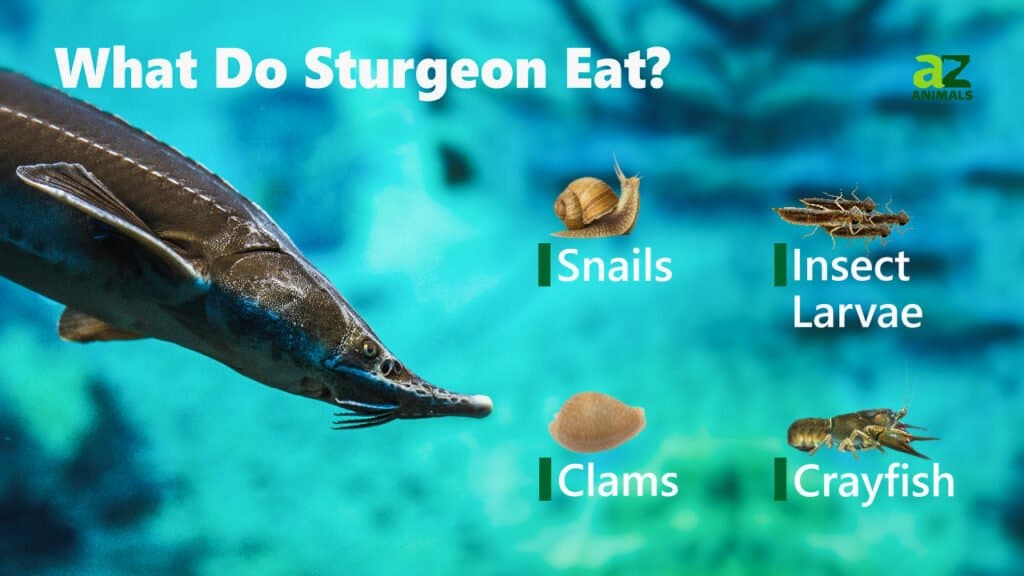
Sturgeons eat snails, insect larvae, clams, and crayfish.
©/Shutterstock.com
These fish are bottom feeders, subsisting mostly of shells, invertebrates, crustaceans, and small fish. Some larger species may consume larger fish and are capable of swallowing an entire salmon whole.
Reproduction and Lifespan
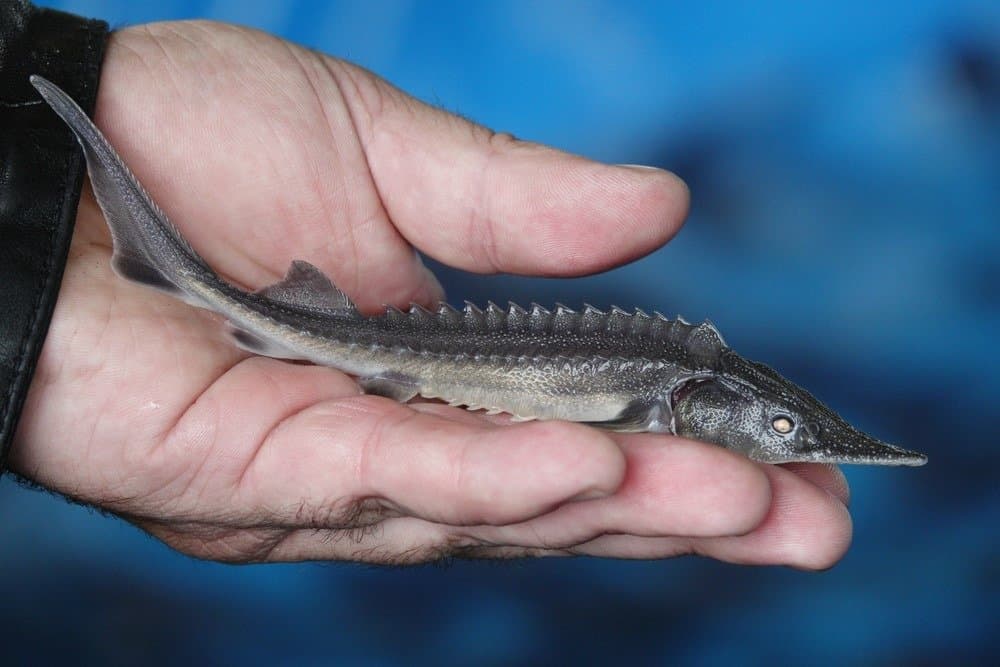
These fish have a lifespan of 50 to 60 years on average, though many can reach 100 years or beyond.
©Konstantin Baidin/Shutterstock.com
Long-lived fish, these fish live for an average of 50 to 60 years; many individuals live for 100 years or longer.
As broadcast spawners, they reproduce through external fertilization. Females lay an average of 100,000 to 3 million eggs at a time, but not all are ultimately fertilized. The eggs become sticky and end up adhering to bottom substrates.
After a gestation period of eight to 15 days, larval fish follow river currents downstream into backwater areas. Small fry ultimately migrates back to big rivers. Many species are anadromous, meaning that they migrate up rivers to spawn.
Fishing and Cooking
Fishing for these fish is permitted in many areas, but strict regulations are in place to prevent overexploitation. Lake sturgeon, in particular, are popular sports fish in North America.
As a food source, these fish are prized mostly for their flesh and roe. The latter is used to make what is regarded as the finest caviar in the world, which led to the massive overexploitation of the fish for many years. Sturgeon flesh is also popularly smoked, pickled, or cooked fresh. Isinglass, a pure form of gelatin found in sturgeons’ swim bladders, was long prized for a variety of industrial uses.
View all 293 animals that start with SSturgeon FAQs (Frequently Asked Questions)
What do sturgeons eat?
Sturgeons are bottom-feeders, and their diets mostly consist of crustaceans, small invertebrates, shells, and small fish. Larger species may consume large fish as well.
How long do sturgeons live?
The sturgeon is a long-living fish. Many species do not reach sexual maturity until around the age of 20 years. On average, their lifespan ranges from 50 to 60 years, but many sturgeons live to 100 years or older.
Can a sturgeon kill you?
Sturgeons are not known for aggression to humans and lack teeth for causing serious harm. However, they have been known to hurt or kill humans accidentally. In 2015, a five-year-old girl died after a sturgeon leaped out of the Suwanee River, striking her.
Is it illegal to eat sturgeon?
Some species of sturgeon may be fished and kept for food, but strict restrictions apply. Other species, like the Atlantic sturgeon, are entirely protected, so it is illegal to eat them.
Is a sturgeon a dinosaur?
No. Sturgeons, however, are considered primitive fish because they have experienced few changes since roughly the end of the Triassic period – approximately 245 million to 208 million years ago.
What Kingdom do Sturgeons belong to?
Sturgeons belong to the Kingdom Animalia.
What phylum do Sturgeons belong to?
Sturgeons belong to phylum Chordata.
What class do Sturgeons belong to?
Sturgeons belong to the class Actinopterygii.
What family do Sturgeons belong to?
Sturgeons belong to the family Acipenseridae.
What order to Sturgeons belong to?
Sturgeons belong to order Acipenseriformes.
What type of covering do Sturgeons have?
Sturgeons are covered in Smooth skin.
In what type of habitat do Sturgeons live?
Sturgeons live in oceans, gulfs, and lakes.
How many species of Sturgeon are there?
There are 29 species of Sturgeon.
What is a distinguishing feature of the Sturgeon?
Sturgeons have an elongated body and plates.
What is the biggest threat to the Sturgeon?
The biggest threat to Sturgeons is overexploitation.
What is an interesting fact about Sturgeons?
Large Sturgeon species can swallow whole salmon.
How do Sturgeons have babies?
Sturgeons lay eggs.
What are the differences between paddlefish and sturgeon?
The key differences between paddlefish and sturgeon are their appearance, diet, and lifespan. The tops of sturgeons and paddlefishes are dark, but the pigmentation fades into much lighter ventral colors, and many have white bellies.
Thank you for reading! Have some feedback for us? Contact the AZ Animals editorial team.
Sources
- IUCN, Available here: https://www.iucn.org/commissions/ssc-groups/fishes/sturgeon-specialist-group
- Britannica, Available here: https://www.britannica.com/animal/sturgeon-fish
- IUCN, Available here: https://www.iucn.org/content/sturgeon-more-critically-endangered-any-other-group-species
- Fishbase, Available here: https://www.fishbase.se/summary/2066
- WWF, Available here: https://wwf.panda.org/discover/our_focus/freshwater_practice/freshwater_inititiaves/sturgeon_initiative/

















